| Home Travel Index | First Posted: Apr 15, 2013 Jan 21, 2020 | ||
Cuba Santería ReligionSantería Continued to Templo de Yemaya, where a Santería Practitioner along with some of the religion's devotees explained the basic principles of Santeria. Discussed the role of religion and religious organizations throughout both Cuba and the US. 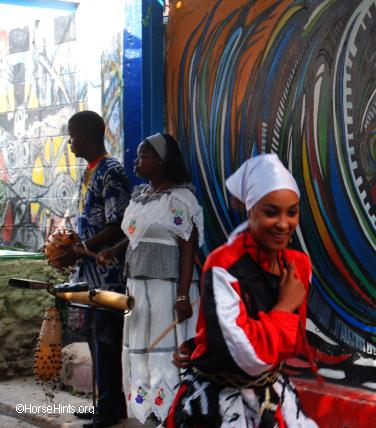 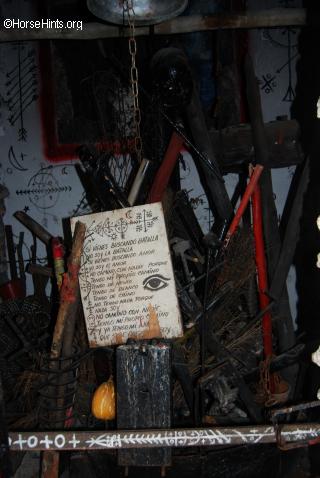 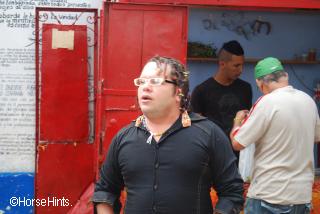 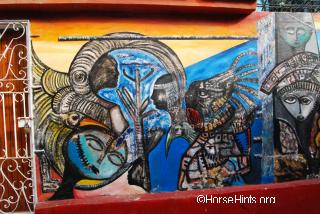 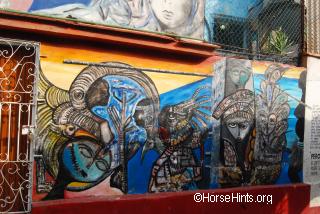 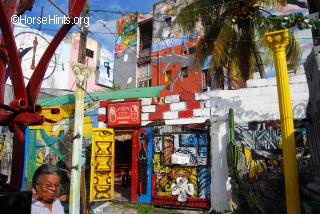  
 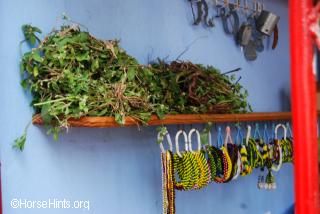 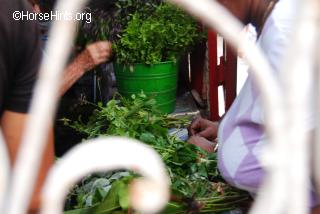
Santería, also known as Regla de Ocha, La Regla Lucumí or Lukumi, is a syncretic religion of West African and Caribbean origin influenced by Roman Catholic Christianity. Its liturgical language, a dialect of Yoruba, is also known as Lucumí. Our guide, Martin, pointed out that the Santoría often are dressed in all white. HistorySantería is a system of beliefs that merges the Yoruba religion (which was brought to the New World by enslaved West Africans sent to the Caribbean to work on sugar plantations) with Roman Catholic and Native American traditions. These Africans carried with them various religious customs, including a trance for communicating with their ancestors and deities, animal sacrifice and sacred drumming and dance .In Cuba, this religious tradition evolved into what we now recognize as Santería. The colonial period from the standpoint of African slaves may be defined as a time of perseverance. Their world quickly changed. Tribal kings and their families, politicians, business and community leaders all were enslaved and taken to a foreign region of the world. Religious leaders, their relatives and their followers were now slaves. Colonial laws criminalized their religion. They were forced to become baptized and worship a god their ancestors had not known who was surrounded by a pantheon of saints. The early concerns during this period seem to have necessitated a need for individual survival under harsh plantation conditions. A sense of hope was sustaining the internal essence of what today is called Santería, a misnomer (and former pejorative) for the indigenous religion of the Lukumi people of Nigeria. In the heart of their homeland, they had a complex political and social order. They were a sedentary hoe farming cultural group with specialized labor. Their religion, based on the worship of nature, was renamed and documented by their masters. Santería, a pejorative term that characterizes deviant Catholic forms of worshiping saints, has become a common name for the religion. The term santero(a) is used to describe a priest or priestess replacing the traditional term Olorisha as an extension of the deities. The orishas became known as the saints in image of the Catholic pantheon. As mentioned, in order to preserve their authentic ancestral and traditional beliefs, the Lukumi people had no choice but to disguise their orishas as Catholic saints. When the Roman Catholic slave owners observed Africans celebrating a Saint's Day, they were generally unaware that the slaves were actually worshiping one of their sacred orishas. Due to this history, in Cuba today, the terms "saint" and "orisha" are sometimes used interchangeably. This historical "veil" characterization of the relationship between Catholic saints and Cuban orisha is made all the more complicated by the fact that the vast majority of santeros in Cuba today also consider themselves to be Catholics, have been baptized, and often require initiates to be baptized as well. Many hold separate rituals to honor the saints and orisha respectively, even though the faith's overt links to Catholicism are no longer needed. In 1974, the Church of the Lukumi Babalu Aye became the first Santería church in the United States to become officially incorporated. Rituals and Ceremonies Santería does not use a central creed for its religious practices; it is understood in terms of its rituals and ceremonies. These rituals and ceremonies take place in what is known as a house-temple or casa de santos (house of saints), also known as an ilé. Most iés are in the homes of the initiated Priests and Priestesses. Ilé shrines are built, by the priests and priestess, to the different orishas which creates a space for worship, called an igbodu (altar). In an igbodu there is a display of three distinct thrones [draped with royal blue, white and red satin] that represent the seats of the queens, kings and the deified warriors. Each ilé is composed of those who occasionally seek guidance from the orishas, as well as those who are in the process of becoming priests. The many cabildos and casas that bridged the 19th and 20th centuries are fondly remembered by contemporary priests as the origins and strongholds of Cuban Lucumí culture and religion. To become a full-fledged Santero or Santera (Priest or Priestess of Santería), the initiator must go through an intensive week-long initiation process in which the teaching of the ritual skills and moral behavior occurs informally and nonverbally. To begin with, the initiator goes through what is called a cleansing ritual. The initiator's padrino (godfather) cleanses the head with special herbs and water. The padrino rubs the herbs and water in a specific pattern of movements into the scalp of the head. However, if a person is entering Santería for the need of healing, they will undergo the rogación de la cabeza (blessing of the head), in which coconut water and cotton are applied on the head to feed it. The ritual of the cleansing of the head cools and refreshes the whole person, wherein the initiator is born again. Once cleansed, there are four major initiation rituals that the initiator will have to undergo, which are: obtaining the beaded necklace, receiving the Eleggua, receiving the warriors, and making saint. The first ritual is known as the acquisition of the beaded necklaces (known as elekes); according to De La Torre, "the colors and patterns of the beads on the elekes will be those of the orisha that serves as the iyawo's (bride) ruling head and guardian angel and so the first thing that must be done is to determine who the orisha is. This must be done by a babalawo (fortune teller), in a divination ritual known as bajar a Orunla (go down to Orunla)." The elekes necklace is bathed in a mixture of herbs, sacrificial blood and other potent substances and given to the initiated. The initiate most often receives the necklace of the five most powerful and popular orisha, as the multicolored beads of the elekes are each patterned for the primary Orishas (Ellegua, Obatala, Yemaya, Chango and Oshun), and they serve as a sacred point of contact with these Orishas. When the necklace is received, the initiated must bow over a bathtub and have his/her head washed by the orisha. The elekes serves as the sacred banners for the Orishas and act as a sign of the Orisha's presence and protection; however, it must never be worn during a women's menstruation period. The second important ritual is known as medio asiento, the creation of an image of the orisha Eleggua. The individual will go through a consultation with a Santero, where all the recipients' life, past present and future, will be reviewed. During the consultation, the Santero determines which of the 21 paths of Eleggua the recipient will receive. Then, based on his findings, he chooses materials that will be used to construct the image of the Eleggua, a sculpture that is used to keep evil spirits away from the initiator's home. This ritual is only prepared by men as the orishas takes some of the Santero's "manly" spirit in the process. The third ritual, known as the "receiving of the warrior", is a ritual where the initiated receives objects from their babalawo that represents the warriors; Iron tools to represent Oggun, Lord of Iron; an iron bow and arrow to represent Ochosi, the Divine Hunter; and an iron chalice surmounted by a little rooster to represent Ósun, the messenger of Obatalá. This ritual begins a formal and lifelong relationship that the initiate will have with these Orishas, as the orisha's devote their energies to protecting and providing for the initiate on his path. The last ritual of the initiation process is known as Asiento [ascending the throne], and is the most important and the most secretive ritual in Santería, as it is the ceremony where the iyawo (bride) becomes "born again" into the faith. This ritual is a culmination of the previous rituals, and cannot be made unless the others have been completed. Prior to the ritual, the individual is considered to be impure and is required to "die" from their old self. Asiento is a process of purification and divination whereby the initiated becomes like a newborn baby and begins a new life of deeper growth within the faith. Once the initiation is completed, there is a year-long waiting period, known as iyaboraje, in which the newly appointed Priest and Priestess can not perform cleansings and other remedies. It is a time where the Iyawo or Bride of the Orisha must follow a strict regimen of wearing all white and must avoid physical contact with those who have not been initiated. Once the ebo del año has been completed there will be an end of year ceremony, which will enable the Priest or Priestess to consult clients, perform cleansings, provide remedies and perform initiations. And according to Gonzalez: "they are also regarded as royalty in the religion, as they are considered representatives of the Orishas and are vested with the power to work with the forces of those Orishas in full." With Santería rituals there are musical ceremonies and prayers which are referred to as bembé, toque de santo, or tambor. It is a celebration dedicated to an Orisha, where the batá drums (set of three drums known as the iya (the largest drum), itoltele, and oconcolo) are played in the Orisha's honor. Through these sacred drums, messages of worshippers reach the orishas and the orishas respond to their devotees. These drums are used only by men and must always be treated with respect; for example: dancers must never turn their backs towards the drums while dancing, as it is considered disrespectful. Clergy Priests are commonly known as olorishas or owner of Orisha. Once those priests have initiated other priests, they become known as babalorishas, "fathers of orisha" (for men), and as iyalorishas, "mothers of orisha" (for women). Priests can commonly be referred to as Santeros and Santeras (depending on gender), and if they function as diviners (using cowrie-shell divination known as Diloggun) of the Orishas they can be considered Italeros, or if they go through training to become leaders of initiations, Obas or Oriates. Considered to be highest in rank are priests of Ifá (pronounced: [i'fa], ee-FAH), which in santería is an all-male group. Ifá Priests receive Orunmila, who is the Orisha of Prophecy, Wisdom and Knowledge. Once this happens they are known by the title Babalawo, or "Father Who Knows the Secrets". In recent years, a particular practice of the traditional Yoruba Ifa priests (from Nigeria) has come to the diaspora of initiating women to be Iyanifa or "Mother of Destiny", but Lucumí practitioners do not typically accept this practice due to their interpretation of the Odu Ifa Irete Untelu which states women cannot be in the presence of Olofin (otherwise known as Igba Iwa Odu) and so cannot be initiated as divining priestesses. This is a major difference between traditional Lucumí Ifa practitioners, and some traditional Yoruba practitioners from Oshogbo and, since the 1980s, Ile Ife. Instead, a woman in Lucumí is initiated as Apetebi Ifa, a "bride of Ifa", and is considered senior in Ifa to all but a fully initiated Babalawo. There was little evidence of Iyanifa existing in West Africa until very recently, so the existence of the Iyanifa is likely to be of modern origin in Yorubaland, and it is probably due to this reason that it does not appear in the Cuban variant. The foremost Western academic authority on Ifa, William Bascom, traveled throughout Yorubaland studying the Ifa cult in a series of visits in 1937-38, 1950-51, 1960 and 1965, and never encountered a single Iyanifa nor was he told of their existence by any of his informants. However, Maupoil, in his 1943 doctoral thesis, does mention he encountered a woman Ifa diviner in Dahomey. Cuban Traditional Healing Practices Cuban traditional healing practices are rooted in the spiritual and ethnic religious influences of Western Africa. Having a strong spiritual component, Cuban traditional healing practices also use the pathways of the herbalist, psychologist, ethicist, social worker and that of a respected spiritual medium interceding between God and human beings. Du Toit refers to Cuban traditional healing practices as ethnomedicine which taps on the biodynamic chemical properties of certain plants, from which some commercial drugs were derived, such as the cardiac medications, digitalis, quinine, and curare - chemicals causing neuromuscular paralysis. Du Toit categorizes Cuban ethnomedicine as having health specialists which are: el yerbero (the herbalist), el curandero (the curer), el santero (the religious healer), and el conocedor (the botanist). Du Toit continues, "Cuba is one of the regions in which a great deal of ethnographic and ethnobotanical research has been conducted." Du Toit cites the studies of Lydia Cabrera on the religious and healing role of indigenous medicinal plants, and Jose Gallo on the 900-page compilation of folk medicine, and also mentions that with the 31 herbs prescribed as bronchodilators, only Datura candida was effective, due to its contents of scopolamine and atropine in the leaves. Lemongrass or caña de limón is used for low blood pressure and anti-inflammatory effects. Thyme tea and castor oil are used to speed the delivery of babies and the broomweed (Corchorus siliquosus) induces the quick expulsion of the placenta. Herbs are also used to create a trance possession using the hallucinogenic properties of Datura metel and Datura stramonium (both have scopolamine and atropine, causing amnesia), the psychoactive ingredients from the cane toad (Bufo marinus). Aside from being herbalist, Santería traditional healing practice has a spiritual aspect. Derived from its Yoruba religious roots or Lucumí tradition, Santería has a holistic approach, acknowledging the connection with heart, mind and body. In Santería, the world flows with the primal life energy called the ache or growth, the force toward completeness and divinity. Ache is the current that Santería initiates channel so that it empowers them to fulfil their path in life, because ache is connected to all that has life or exhibits power; ache comprises blood, grace, power. When a person is sick, the healer thinks, interprets and reacts, considering the illness not just a physical dysfunction but also an interface with suffering and bad luck in life, believed to be brought on by the activity of spirits. Prevalent in the African Caribbean cultures, espiritismo is a part of the Latin American traditional healing practice. Du Tout reveals that Cuban Santería has a "strong element of spiritism." McNeill also concurs that some Santeros have the power to communicate with spirits asking for guidance to improve the situation of a person consulting. However, in general, the Santeros of the Regla de Ocha and the other Cuban traditional healing practice, the Babalawos of the Regla de Ifa primarily turn to religion as their practice to address personal challenges and identify means to improve a situation. Many people may go and see espirititas who don't see a Santero. Also, espiritistas may work hand in hand with Santeros and Babalawos. Psychotherapy and espiritismo are not that far apart. Psychotherapy uses allopathic or Western principles, and spiritism uses homeopathic principles which aim to reduce the anxiety, or permit the patient to acknowledge pent-up emotions, unexpressed guilt, or repressed behavior through catharsis meant to release emotions the patient may not even be aware of.It is said that "healing can occur when the spirit medium assists the sufferer to come into harmony with the spirit world so as to change his or her physical condition, emotions, way of life, or destiny." The reputation of espiritistas was tinged with negativity, being accused of witchcraft because they deal with health through the unfamiliar paradigm of the spirit world, which is not understood by either the medical doctors or the Catholic priests. Consequently, espiritistas or traditional healers of the Santería and other Latin American cultures working with healing through the spirit world are attacked as "works of the devil" from the pulpits of the Catholic Churches and labeled as "quackery" from the journals of the medical profession. To those who have painstakingly studied the Afro-Caribbean traditional healing systems, this unique system of knowledge is appreciated as ethnopharmacology or ethnomedicine. Aligning and harmonizing with the forces of nature, practitioners of the Regla de Ocha / Ifa invoke on the guidance of Orishas. There are three foremost Orishas that are predominantly concerned with folk-healing, however, other orishas may be invoked to help a person with a specific problem. These main orishas are: Osain, the lord of the herbs, and Babaluye-Aye, the ruler of contagious diseases and Inle, the patron of physicians. Osain is the patron of curanderos or traditional herbal healers, also called Osainistas. According to de la Torre, Osain is believed to be embodied in the omiero which is a combination of "blood from sacrifices offered during the ceremony and juices extracted from herbs that are sacred to the Orishas with water (from rain, rivers, or seas) honey, aguardiente, powdered eggshell, corojo and cocoa butter." The forest has everything that would maintain a robust health and keep a person away from malevolence, thus, Santería practitioners would agree that no spell will be able to work without the sanction of Osain, the master herbalist commanding the healing secrets of plant life. Osain is syncretized with Saint Joseph, Saint Benito, or Saint Jerome. Babaluye-Aye, the orisha of contagious and epidemic illnesses, is revered by its victims and survivors like smallpox, leprosy and skin diseases. Babaluye-Aye has become the guardian of those with AIDS. He is syncretized with the poor beggar Lazarus in Jesus's parable. Inle is the patron of Cuban physicians, known as a healer who favors scientific methods. Although he is a beautiful youth and among the sixteen most-worshipped orisha, Inle is ranked as one of the orishas that is approached for very specific health issues. Inle is also known as the protector of the homosexuals. People go to a consulta because of some physical ailment or personal problem affecting their health. Divination is a means that traditional healers utilize to inquire further on the details of a problem. Divination may articulate the origin/cause of the problem; in addition, it may include prescriptions for solutions/suggestions to certain difficulties. Divination establishes an interpretative frame for the situation a person finds himself in. Hence, the Santeros offer cowrie-shell divination or other appropriate traditional practices. Rituals, or the reading of Patakis may be done to clarify a problem which sometimes the person consulting may not even be aware of. Passed orally from many generations, Patakis are parables used by Lucumí diviners to guide or give insights or moral lessons to a people who come for consultation. The Patakis recited by the Santero corresponds to the number that the cowrie shell divination brings. Aside from the use of herbs and divination, the Santería traditional healing is achieved through rituals that include animal sacrifice, offerings, altar building, music, dance, and possession trance. When the patient is a child, the Santero uses the curative system known as santiguo which means "to heal by blessing." Perceiving some health problems, most Santeros in Cuba recommend that the client seeks a medical doctor for a check-up. Parallel to the medical treatment, the patient might be prescribed some herbal teas, cleansing baths, or a special diet from the traditional healing practice. Sometimes, a Santero might advise a client to receive omiero, whose efficacy, people unfamiliar with the paradigm of traditional healing practice, would be considered as "magical herbal elixir" and thus, conjectured as resulting to "miracle cures." An omiero is a sacred mixture that is made up for very specific Santería ceremonies and is believed to embody the orisha ruler of herbs, Osain. Most clients who see Santeros would never be told to drink it. The Santería of the Regla de Ocha and the Babalawos of the Regla de Ifa are just two of the many traditional healing practices used in the Afro-Caribbean cultures. Being so attuned to the natural world, these traditional healers bring this sensitivity to assist in the holistic improvement of a patient. Owing to the unique form of Cuban transculturation, traditional healing practices are practised side by side with Western allopathic medicine through the progressive, universal Cuban healthcare system. Cuban healthcare integrates the biopsychosocial model which is geared towards preventive and community-oriented psychology, with the general health philosophy of the country Traditional healers recognize but do not compete with Western medicine. Western medicine may treat physical ailments, but the Cuban traditional healing systems deal with emotional, mental and spiritual issues. In fact, unlike other cultures, the Cuban people do not hesitate to go to their local hospital in addition to consulting the traditional healers. Current Distribution The traditional Yoruba religion and its Santería counterpart can be found in many parts of the world today, including Cuba, Puerto Rico, Dominican Republic, Panama, Colombia, Venezuela, and the United States, mainly as a result of mostly Cuban and Puerto Rican migration. In 2001, there were an estimated 22,000 practitioners in the US alone, but the number may be higher as some practitioners may be reluctant to disclose their religion on a government census or to an academic researcher. Of those living in the United States, some are fully committed priests and priestesses, others are "godchildren" or members of a particular house-tradition, and many are non-committal clients seeking help with their everyday problems. Many are of Black Hispanic and Caribbean descent, but as the religion moves out of the inner cities and into the suburbs, a growing number are of African-American and European-American heritage. In Puerto Rico is mainly practised by adherents residing in the municipalities of Loiza, Carolina and Bayamon. Operating independently of the historical syncretism described above, there are now individuals who mix the Lucumí practices of Cuba with traditional practices as they survived in Africa after the deleterious effects of colonialism. Although most of these mixes have not been at the hands of experienced or knowledgeable practitioners of either variant of the system, they have gained a certain popularity. A very similar religion called Candomblé is practiced in Brazil, along with a rich variety of other Afro-American religions. This is now being referred to as "parallel religiosity" because some believers worship the African variant that has no notion of a devil and no baptism or marriage, yet they belong to Catholic or mainline Protestant churches, where these concepts exist. Controversies and Criticisms In 1993, the issue of animal sacrifice was taken to the Supreme Court of the United States in the case of Church of Lukumi Babalu Aye v. City of Hialeah. The court ruled that animal cruelty laws targeted specifically at Yoruba were unconstitutional. The Yoruba practice of animal sacrifice has seen no significant legal challenges since then. In 2009, legal and religious issues that related to animal sacrifice, animal rights and freedom of religion were taken to the United States Court of Appeals for the Fifth Circuit in the case of Jose Merced, President Templo Yoruba Omo Orisha Texas, Inc., v. City of Euless. The court ruled that the Merced case of the freedom of exercise of religion was meritorious and prevailing and that Merced was entitled under the Texas Religious Freedom and Restoration Act (TRFRA) to an injunction preventing the city of Euless, Texas, from enforcing its ordinances restricting his religious practices relating to the use of animals, (see Tex. Civ. Prac. & Rem. Code § 110.005(a)) without the court having to reach his claims under the First and Fourteenth Amendments. The city of Euless, even after losing a drawn-out lawsuit that tested the boundaries of religious liberty in Texas, was still searching for new ways to shut down Merced's spiritual practices. There have been a few highly publicized cases where injuries allegedly occurred during Lukumi rituals. One such case reported by The New York Times took place on January 18, 1998, in Sayville, New York, in which 17-year-old Charity Miranda was suffocated with a plastic bag at her home by her mother Vivian, 39, and sister Serena, 20, after attempting an exorcism to free her of demons. Police found the women chanting and praying over the prostrate body. Not long before, the women had embraced Lukumi. However, Lukumi doctrine does not postulate the existence of demons, nor does its liturgy contain exorcism rituals. The mother, Vivian Miranda, was found not guilty due to insanity and is currently confined in a New York State psychiatric hospital for the criminally insane.For More Articles on Cuba: CubaCuban Cigars Cuban Daiquiri Helpful Cuba Tid Bits to Know Before Visiting Cuban Paladars Salvador Gonzáles Escalona Cuba Yank Tanks, American Cars in Cuba Galleries: |